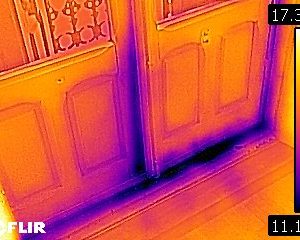Airtightness performance of the building envelope of dwellings in Spain. Characterisation and energy impact of air infiltration
| PhD in Architecture |
| Doctor: Irene Poza Casado |
| Date of reading: 15/12/2021 |
| Directors: Dr. Jesús Feijó Muñoz, Dr. Alberto Meiss, Dr. Miguel Ángel Padilla Marcos |
| Court: Dra. Pilar Linares Alemparte (Consejo Superior de Investigaciones Científicas - CSIC) (President), Dra. Nuria Casquero Modrego (Lawrence Berkeley National Laboratory) (Vocal), Dr. José Antonio Balmori Roiz (Universidad de Valladolid) (Secretary) |
Introduction
The countries of the European Union predict a sustainable, competitive and decarbonised energy system by 2050. For that purpose, it is crucial to address the energy efficiency of buildings, which are responsible for a significant percentage of energy consumption. The potential seems obvious, considering that, according to the European Commission, 75% of the buildings in Europe are energy inefficient.
In this context, uncontrolled airflow through the building envelope, or air infiltration, is a phenomenon that involves energy loss. Air infiltration is also related to IAQ in buildings and, thus, a relationship is established between air infiltration, energy impact and ventilation. Since airtightness is the main characteristic of the envelope that determines air infiltration, its study is essential to understand the performance of the building envelope.
However, this issue has not been addressed in depth in most countries with temperate climates, and, specifically, in Spain, given the traditional dependence of air renewal on air infiltration. Currently, air infiltration is no longer necessary as an air renewal source and, consequently, its reduction is a priority to achieve nearly zero-energy buildings (nZEB). In this sense, the airtightness characterisation of the envelope of existing buildings is essential to prioritise efforts and determine strategies for the renovation of the existing building stock.
Objectives
To meet these needs, the general objective of this work focuses on the characterisation of the airtightness of the envelope of residential buildings in Spain. As a starting point, the airtightness regulatory frameworks and main databases in Europe and North America were assessed. Its analysis allowed the identification of the weaknesses, threats, strengths, and opportunities of these practices.
Development
The characterisation of the airtightness of the envelope of the residential building stock in Spain was carried out in a representative sample of cases. A quota sampling scheme defined by climate zone, location, year of construction, and building typology, was proposed. This sample generated a database that collects information on the complete characterisation of both construction features and the airtightness of buildings.
The airtightness of the case studies was evaluated by means of fan pressurisation tests. In addition, a specific methodology was developed to guarantee the uniformity and reliability of the information gathered. Airtightness results were wide-ranging, which indicates the uneven performance of the buildings tested. Nevertheless, the distribution of the average values was in line with previously reported findings both in Spain and in other European countries.
Contrary to what might be expected, no clear trend of airtightness improvement was observed with regard to the year of construction. The different regulations regarding the energy efficiency of buildings did not lead to a significant improvement of the airtightness of the building envelope. However, the recent regulatory limitation of the global air permeability of the envelope opens a window to a change in this trend and represents an opportunity for real achievement of nZEB.
The relationship between different building characteristics and the degree of airtightness was addressed through statistical analysis. A relationship was identified between the airtightness and the type of windows, the rolling-shutter system used, and the degree of retrofitting of the envelope. In this sense, the main leakage paths were located using infrared thermography, which allowed the identification of typical deficiencies of residential buildings in Spain mostly around windows and rolling shutters. The inadequate design of the constructive solutions, as well as the careless workmanship of the joints between different elements, were pointed out as the main causes that prevent airtight envelopes.
Finally, the energy impact of air infiltration on the heating and cooling demand in the cases studied was addressed, applying a simplified model.
Conclusions
The results demonstrate that infiltration can be responsible for up to 25% of the heating demand. This confirms the substantial potential for energy-saving if the air permeability of existing buildings was reduced.
The characterisation of the airtightness of the envelope of residential buildings in Spain contributed to filling the knowledge gap identified. Only in this way will future design criteria and renovation strategies of existing energy-inefficient buildings be approached in a realistic way, in accordance with the established decarbonisation targets.
